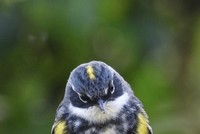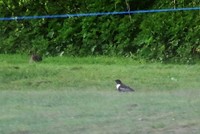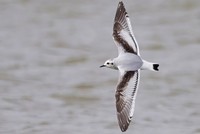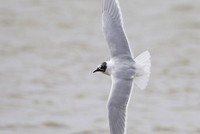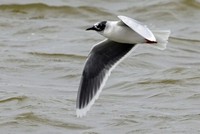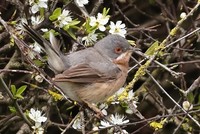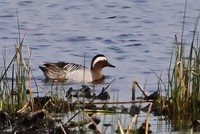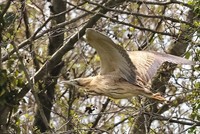The Birds of the Iberian Peninsula
Eduardo de Juana and Ernest Garcia
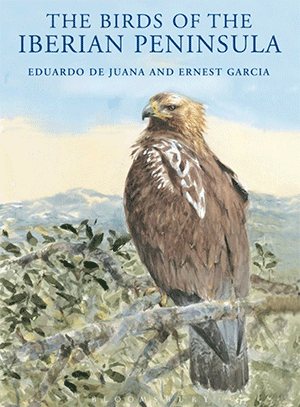
Birdlife's Spoon-billed Sandpiper campaign
What’s not to like about the Iberian peninsula? Between them, Spain and Portugal represent a fabulously rich and diverse cornucopia of habitats, are sandwiched between the Atlantic and Mediterranean, are practically a stone’s throw from Africa… and unsurprisingly then, the region’s avifauna is like a complex paella chased with a pastel de nata – packed with a myriad of good things, and deeply satisfying.
I should probably declare an interest – I’ve lived there, I’ve worked there, I go back there every few months. I’m an unashamed fan of the region – and so it was with immense anticipation that I waited for the latest offering from Helm’s illustrious stable to thump onto my doormat. And thump it did – to do justice to the region demands a magnum opus, and that’s precisely what Eduardo de Juana and Ernest Garcia have created in “The Birds of the Iberian Peninsula”. Nearly 700 pages of fine print weighs in at a shade under two kilos – that’s a seriously large amount of content.
And what of that content? There have been two individual, comparatively recent regional works published in the past twenty years, one apiece in Portuguese and Spanish. The authors of this book acknowledge those who have gone before them, but have set out to not only assimilate all the very latest advances in knowledge of the region’s avifauna, but to present their work in English and hence make it more easily accessible to a wider readership. Their logic is impeccable, and one has to commend them for doing real justice to their objectives; the amount of effort, work and I daresay love that’s gone into this production is considerable.
Short informative essays (and a small selection of colour photos of habitat and a number of birds) set the scene in the early pages – Iberia’s geography and climate; habitats; and specifics of the avifauna are quickly and deftly handled by way of introduction to the main heft of the book – the species accounts. It is here that one can easily lose hours of one’s life – there is just so much information crammed into these pages it’s all too easy to become drawn in and emerge, head reeling with facts, a long while later. These species accounts vary in length and detail depending on the status of the species in question – those that are found regularly in the region getting the most coverage, as one would reasonably expect. Good use is made of accurate maps, figures and tables to illustrate geographic and seasonal distribution, and population trends.
(A minor quibble is the lack of pictorial content, in particular artwork. While some vignettes would add nothing materially to the content, aesthetically they might have enhanced and leavened the text. However, this is no county bird report, and in the interests of space and economy I can well imagine that some compromises had to be made).
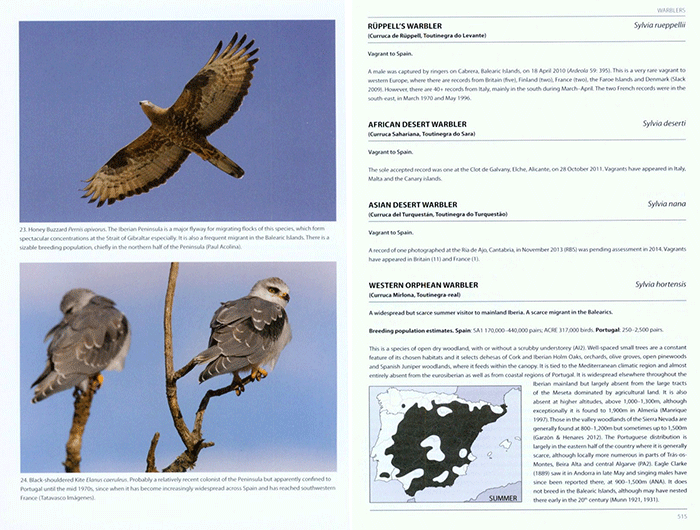
Of course, amidst the considerable detail of the regularly occurring species in the region there are interspersed the scarcer and downright rare vagrants; and I wouldn’t be human if I didn’t take every bit as much an interest in, for example, the region’s records of Pallid Harrier as I do the account of Spanish Imperial Eagle…
There is, inevitably, a time lag between a manuscript’s completion and a book coming to press. With a publication of the nature of this one, including vagrant bird occurrences, there is an inherent danger that this immediately dates the book. That all pending vagrant bird records for the region up to 2012 and a number of the more interesting records from up to late 2013 are incorporated shows an attention to detail on the part of the authors that clearly persisted until the very last moment possible. Potted histories of each species in question’s occurrence elsewhere in nearby Europe and North Africa provide useful context for the Iberian records; and on occasion, serve as a timely and tantalising reminder of what is possible where wandering rarities are concerned…
Published: Feb 2015
Helm
Hardback: Pages: 688
ISBN: 9781408124802
RRP: £59.99
SPECIAL OFFER:
Pay just £46.99 inc FREE p&p when you quote discount code RBA77
Very important please read before ordering: When ordering via WildSounds, the value of the voucher will be deducted from your order when the order is processed. The total displayed on your shopping basket excludes the value of the promo but this will be applied before final payment is taken.
“Preliminary results from 12 [geolocator-tagged] Zino’s Petrels have revealed that the birds ranged widely in the northeastern Atlantic during their breeding season, April-September, reaching the waters off southwestern Ireland and also occurring off the Iberian west coast”. If ever there was a call to arms for sea-birders in either region, this is it! However, this quote serves to illustrate a broader strength of this book – the species accounts are studded with relevant and engaging snippets of information that not only provide context but also elevate the text from being merely a dry recital of information into a genuinely fascinating read.
The species accounts for the breeding species of the region are particularly strong in this regard; that for Red-knobbed Coot, for example, being a concise and typical account incorporating amongst others history, ecology, and human interventions both positive and deleterious. The account for Glossy Ibis demonstrates the value for the non-Iberian-resident birder picking up this book - context to the recent upsurge in Glossy Ibis records for northern Europe is provided in the detailed description of the species’ resurgence as a Spanish breeding bird over the period 1991-2010. The high mortality of the reintroduced Northern Bald Ibis makes for a sobering counterpoint to this Glossy Ibis success, reminding us that all is far from well or easy where European conservation is concerned; and as for the observations regarding the pattern of Ruddy Duck occurrence in Spain… I don’t want to provide too many plot-spoilers, and will instead urge that anyone interested in the ramifications of the British cull of Ruddy Ducks should buy a copy of this book.
And that’s a positive note that I’d like to close upon – I really can’t recommend highly enough that anyone with even a passing interest in the avifauna of the Iberian peninsula should get hold of this superb book as soon as they possibly can. If you’ve enjoyed birding in Spain or Portugal, you’ll find much in it to enhance your knowledge and hasten your next trip back there. If you’ve yet to go birding there, there could be no finer way to whet your appetite and plan precisely when and where you’d like to go and what you’re aiming to see.
Jon Dunn
www.jondunn.com
05 May 2015


